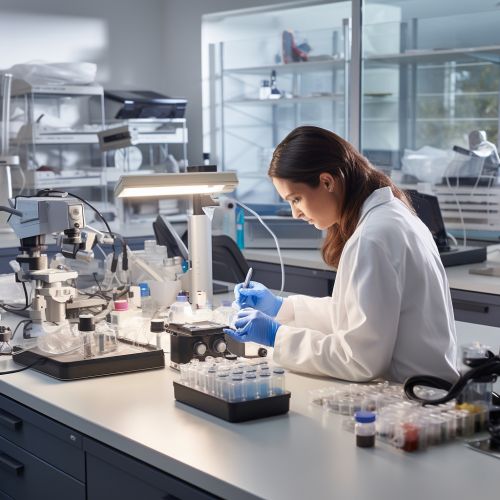Site-directed mutagenesis
Introduction
Site-directed mutagenesis (SDM) is a molecular biology method that is used to make specific and intentional changes to the DNA sequence of a gene and its corresponding protein product. This technique is significant as it allows scientists to study the function of a specific protein sequence by observing the effects of single amino acid substitutions.


Background
The development of site-directed mutagenesis marked a significant advancement in the field of molecular biology. The technique was first described in 1978 by Michael Smith, a biochemist at the University of British Columbia, who was awarded the Nobel Prize in Chemistry in 1993 for his work.
Principle
Site-directed mutagenesis works on the principle of specific base pair changes in the DNA sequence. This is achieved by using a DNA template that contains the desired mutation. The DNA template is a single stranded DNA molecule that is complementary to the DNA sequence of interest, except for the desired mutation.
Methodology
The methodology of site-directed mutagenesis involves several steps, which include the design of primers, PCR amplification, transformation, and verification of the mutation.
Primer Design
The first step in site-directed mutagenesis is the design of primers. These primers are short, single-stranded DNA molecules that are complementary to the DNA sequence of interest, but with the desired mutation. The primers are designed such that they anneal to the DNA template and initiate the synthesis of a new DNA strand during PCR.
PCR Amplification
The next step is PCR amplification. In this step, the DNA template and the primers are mixed together in a solution that contains DNA polymerase and nucleotides. The solution is then subjected to a series of temperature changes, known as the PCR cycle, which results in the amplification of the DNA sequence of interest.
Transformation
Following PCR amplification, the DNA is then transformed into a host organism, usually a strain of E. coli. This is done by mixing the DNA with the bacteria and then subjecting the mixture to a heat shock, which causes the bacteria to take up the DNA.
Verification of Mutation
The final step in site-directed mutagenesis is the verification of the mutation. This is usually done by sequencing the DNA to confirm that the desired mutation has been incorporated.
Applications
Site-directed mutagenesis has a wide range of applications in various fields of biological research. These include the study of protein function, protein engineering, and the development of disease models.
Study of Protein Function
One of the primary uses of site-directed mutagenesis is in the study of protein function. By altering specific amino acids in a protein, scientists can gain insights into the role of these amino acids in the protein's function.
Protein Engineering
Site-directed mutagenesis is also used in protein engineering, where it is used to alter the properties of a protein to make it more useful for a particular application. For example, it can be used to increase the stability of a protein, to improve its binding affinity, or to change its enzymatic activity.
Development of Disease Models
Another important application of site-directed mutagenesis is in the development of disease models. By introducing specific mutations into a gene, scientists can create models of genetic diseases in the laboratory. These models can then be used to study the disease and to test potential treatments.
Limitations
While site-directed mutagenesis is a powerful tool, it is not without its limitations. One of the main limitations is that it can only be used to introduce small changes to a DNA sequence. For larger changes, other techniques, such as genome editing, may be more appropriate. Additionally, site-directed mutagenesis requires a high degree of precision and technical skill, and even then, it is not always 100% efficient.
Conclusion
Despite its limitations, site-directed mutagenesis remains a crucial tool in molecular biology. Its ability to introduce specific changes to a DNA sequence has made it invaluable in the study of protein function, protein engineering, and the development of disease models.
